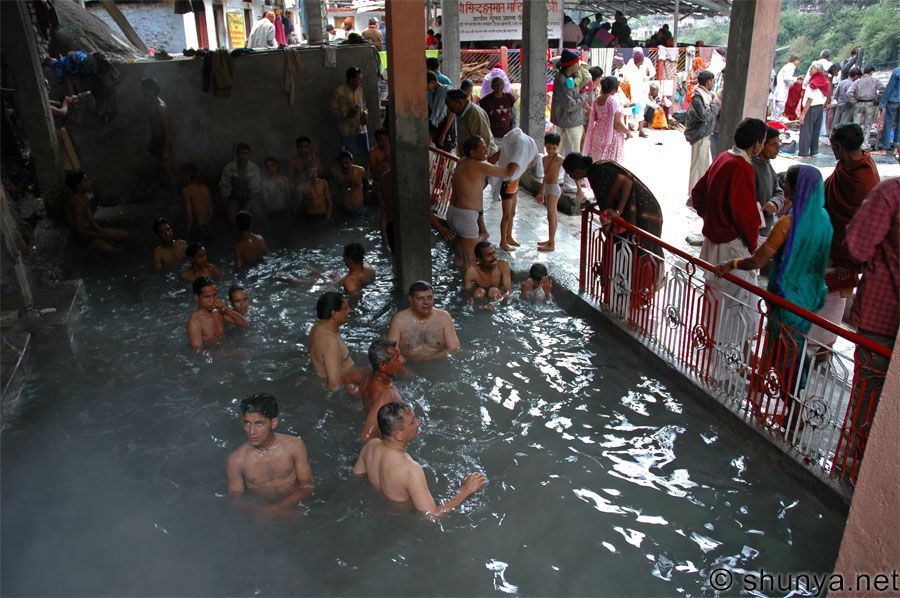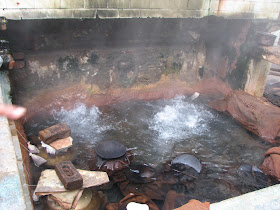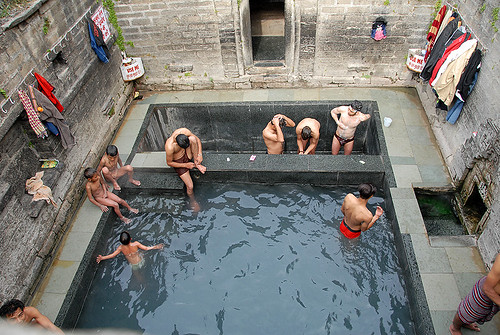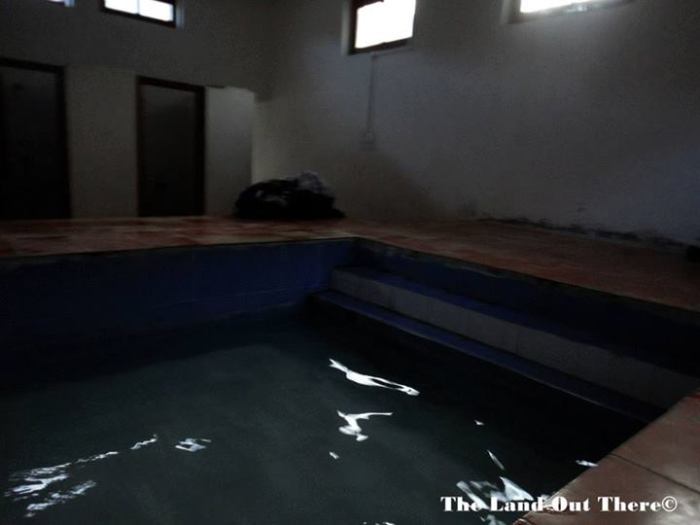Heading westwards from Nepal along the Himal the next Indian state is the state of Uttarakhand. Uttarakhand has only existed as an administrative entity for not even 15 years.
The scientific paper concerning (potential) Geothermal Energy uses in Uttarakhand [1] notes there are
So let's see what's on offer.
The scientific paper concerning (potential) Geothermal Energy uses in Uttarakhand [1] notes there are
'more than 50 individual occurrences of moderate to high temperature springs'.Furtheron:
'Some of the wellknown hot springs are located in Tapoban, Suryakund (Yamnotri), Gagnani, Badrinath, Garam Pani near Nainital, and Gaurikund (near Sonprayag). Several hot springs occur between Pala and Gangnani, north of Uttarkashi'.The unseenuttarakhand web site mentions 9 hot springs in some details. Some caution as some of the text has been literally copied from an earlier version of this blog post!
So let's see what's on offer.
Purification
The westernmost district of Uttarakhand, Uttarakashi, possesses no less than 4 hot springs. Two of these have extensive fame as heading for the head waters of the Ganga (Gangotri) and Yamuna (Yamunotri) is part of Indian culture and dharma (see Wikipedia's Chota Char Dham Yatra page). Visits to either purifying sins and seeking salvation are the main motives of visitors (source).
Though after researching for this chapter I believe that they may not be as appealing to non-believers. Take note of this blog entry:
'I think mass bathing is in our culture and I have grown accustomed of being semi nude with hundreds of other fellow travellers'.Don't be shocked either, semi-nude means half clothed!
Death by torture
Westernmost of Uttarkashi's hot springs are those associated with Yamunotri, which lies at the end of highway 94 originating in Rishikesh. Yamunotri basically is a temple near the very head waters.
Nearby the temple are a number of thermal springs; by far the most well known is that of Suryakund. Somehow human soaking is less prevalent in this hot spring:
'Devotees fasten rice and potatoes in a cotton cloth, and dip it in the water to be cooked. The water is so warm that the food gets prepared within few minutes. This cooked food is the main offering in the temple. A hot water spring in the precincts of snowy strengthens one's faith in the spirituality of the place'.The other kind of soaking takes place in Gaurikund hot spring. Some accounts: Adventures in India:
'There was a small temple across the river, where we had to take off our shoes outside on the freezing cold, wet stairs. It was better once we got in the temple though, where there were hot spring baths for both men and women. On the women’s side, we went to the side of the tank and washed our faces with the hot water that the woman there kept handing us nonstop. Then we went up into the temple where some little boys boiled our rice offering in a hot spring [Suryakund] while we did the puja ritual with the priest (and thank goodness Shama was there to translate!). The ritual was really beautiful, and we felt better about the ride back since the water was supposed to spare us “a tortuous death” and the string around our wrist would protect us'.Nadar Parakh:
'A highlight of Yamunotri is the hot spring. Men have an open air pool, murky brown and reeking of sulphur, whereas women have to battle more valiantly with the dense fumes in a closed tin shed. But the water is hot, and at that point nothing could be more important than escaping the ice outside. The only drawback to this dip, other than the fact that the water looks highly highly questionable, is that the sulphur and heat so alter the blood pressure, that the resulting effect of intoxication makes the walk back down to Jankichatti a challenge. But in religious places, where alcohol is strictly prohibited, the high from this spring is greatly welcome'.Travelgogirl:
'Most memorable was an overnight trip in which we hiked to Yamunotri, the source of the great Yamuna river and holy home to the Hindu goddess Yamuna. The boots came in handy as we climbed the steep hills dotted with temples, although I shed them (and everything else) at the top to enter the women-only ritual bath. One of the most empowering experiences I’ve had, the naked Indian woman sang joyfully as they grabbed our hands and danced around the water fed by a naturally hot spring'.!
Higher up in the mountains is the hot spring of Jankichatti (Janki Chatti) which lies just 5 km from Yamunotri (source).
MustseeIndia: 'A dip in the hot water springs of Janki Chatti is an inevitable part of the Yamunotri pilgrimage and it is quite puzzling that in such a cool surroundings how the spring maintains its hotness pretty well. A bath in the hot water gives revitalizing energy and vigor to the visitors who are very tired of the rugged surroundings. Ponies and dandies can be arranged negotiating the trek for those unable to cope with trek physically'.
Cauldron filled soak?
Gangnani (sometimes referred to as Rishikund) hot spring lies along the road to Gangotri (Uttarkashi district) and thus sees many visitors, but most though only on a touch-and-go basis:
'During the day thousands of pilgrims jump out of their yatra-busses, climb quickly to the hot springs, jump inside with their cloths (some take off their cloths) and jump back to the bus. The women do their laundry in the women’s pool. But, at night, the crowds disappear and the place fills with magic – one of the most relaxed places, with no electricity, very few people and steam coming out of the springs.
But, why didn’t anyone tell us about the million stairs?'
Another first hand experience:
'Hot water cascades out from this thermal spring, down a chute from behind the temple, and pours into a men's and a women's pool. This is scalding hot even when it gushes out of the uncovered channel and, judging from the mineral deposits on the channel, it is high in salts but sulphur does not seem to be a major component of them. Quite inadvertently we sipped some of this hot water. It tasted strongly alkaline with a bitter after-taste'.
'This natural hot spring flows from the mountain into a cement bathing platform which is described during pilgrimage season as a fetid soapscum and garbage filled cauldron'.
Gangnani lies north of Uttarkashi district on road 108 towards to Gangotri, roughly half way there.
More from Uttarkashi
Elsewhere (link not working) in the district and upstream of Gangnani lies Sukhi:
Elsewhere (link not working) in the district and upstream of Gangnani lies Sukhi:
'Sukhi is a picturesque village near Harsil in Uttarkashi district. It lies at an altititude of 2,300m. Here saint Sukhdev practicised austeruity. Sukhi has a sot spring where the saint used to take his bath'.
Chaula-Dhungi is another mentioned hot spring which lies in the same Uttarkashi district. This same source also names Banas nearby Hanumanchatti, where the Hanuman Ganga river joins the Yamuna.
When to soak?
As if it's not confusing enough there is another hot spring named Gaurikund in Uttarakhand state. This hot spring is located en route to Kedarnath, another highly significant site of pilgrimage. This Rudraprayag district holy site is, as with Badrinnath (see below), closed for half a year.
Gaurikund is the road head to Kedarnath and as such see's a lot of traffic. Most visitors visit the hot springs on their way back as well as pay respects to the nearby temple of Gauri Devi (source). This seems to contradict this web site which mentions:
'Gaurikund has a hot water spring by the same name and Chardham pilgrims make it a point to take a bath in the hot water before visiting the Kedarnath Shrine'.
Wikipedia mention that ladies (and women then?) can bath in a covered part of the springs.
Nearby is another hot spring named Garam Kund on the right side of the Mandakini river. It is
Nearby is another hot spring named Garam Kund on the right side of the Mandakini river. It is
'... an enclosed hot spring for women with separate dress changing rooms'.
There's also a Garam Kund in Badrinath or not?
And in Bihar state which is nowhere near the Himal.
And in Bihar state which is nowhere near the Himal.
Madkot hot spring, is located near the Nepali border (source).
Smells like eggs because ...
A hot spring still in natural circumstances is Tapovan, near Auli ski field, Chamoli district.
Located along highway 58 northeast of Rishikesh on the way to Badrinath, it also offers soaking opportunities near an adjacent temple. Nearest town is Josimath, 15 km away.
Located along highway 58 northeast of Rishikesh on the way to Badrinath, it also offers soaking opportunities near an adjacent temple. Nearest town is Josimath, 15 km away.
Tapovan is
'... believed [at least that's what this link used to refer to] to posses miraculous healing power'and reeks of what?
'The spring was bubbling hot and the water close to a 100 degrees. An eggy odour reached my nostrils just as Ashwin touched the edge of the water, and smelling it [] declared, “This smells like egg”. Just then I noticed that there were bits and pieces of boiled egg all around it'.
'This yellow sand is good for skin disease'.The nearby soaking experience:
'There is a hot water “kund” (pond) there. Natural hot water flows into a square concrete pond. It is separate for men and women, the women’s side being covered on all sides ...'.
'... we must mention the public pool at Tapovan, near Joshimath. Here the water is hot, clear and quite odourless. Even though there is a little shrine nearby, the pool is, clearly, not regarded as holy. In fact, whenever we've visited it, the men disporting themselves in the pool were quite boisterous. One of them, who described himself as "Ram Prasad, a farmer from this area", said that he had broken his right arm as a child. "There were no doctors in those days but my grandmother put it in a ringal, a Himalayan bamboo splint, and told me to sit in the Tapovan kund every day for an hour for fourteen days. And look at it today... you can't say that it was ever broken..." and he extended his left arm proudly. We thanked him for his story. He had been cured so long ago that he had probably forgotten which arm he had broken!'
Moving On
Another major pilgrimage place is Badrinath which lies more uphill from Josimath. It is estimated that in 2006 more than 600.000 pilgrims visited here, which only can be visited 6 months each year (source). Badrinath is famous for the Shri Badrinathji temple, which is dedicated to Vishnu.
Just below the temple lies the hot spring called Tapt Kund. The relatively small pond is often used for soaking though men and women must alternate bathing times. Can the local men not be trusted?
To enter the temple it's assumed that cleansing oneself in the hot spring beforehand is not such a bad idea.
To enter the temple it's assumed that cleansing oneself in the hot spring beforehand is not such a bad idea.
'It is believed to be the holy abode of Lord Agni. Pilgrims believe that a holy dip in this sacred pond relieves them from their sinful deeds and thoughts'.
'At first I was shocked to witness the writhing mass of half-naked Indian ladies shouting and shoving each other to get to the water. Had the water been a bit cooler I could have waded in and escaped them altogether, but as it was I had to fight for my spot at the edge just like everyone else, and believe me this was no easy task.These Indian ladies had no qualms about grabbing my bucket from my hands, or my soap, or shoving me out of the way if it suited their needs. I invite anyone out there with knowledge on the subject to assess my claims, to defend and/or explain the mentality of these beastly women, because I was (and am) nonplussed. They were worse than animals.By my last visit to the bath, I had grown cold and cynical. When someone grabbed my bucket, I grabbed it back. When someone shoved me to the side, I shoved back. When an Indian woman complained that I was splashing water, I shook my hand dismissively in her direction. When another one bitched because I wasn't adequately covered (the water, like most everything else in these places, is holy), I shouted back with sarcasm, "that's because I'm taking a bath!"Clearly, it was time to move on'.
Moving on, the name Tapt Kund must not be confused with the hot spring of the same name in Bihar state.
Narad Kund is located close to Tapt Kund:
'Narad Kund is a recess in the bed of the Alakananda River which forms a pool and is close to the Tapta Kund. It is sheltered by a projecting rock which breaks the force of the river and allows people to bathe in it'.
Some photo's though do suggest that bathing here may well be a challenge in torrent waters. Considering the lack of info on this, the assumption may well be true ....
Suraj Kund is a popular name for a hot spring, there are hot springs by this name in Sikkim as well as Jarkhand states. That said, this hot spring is next to Tapt Kund in Badrinath. Possibly that is why there is not much mentioned concerning this hot spring ....
Luke warm?
Sahastradhara sulphur spring is somewhat waylaid in Uttarakhand. Located near Dehradun (15 km) this is essentially a beautiful waterfall with geothermal activity nearby.
'The 9 m fall of water of Sahasradhara through the lime shelf unconsciously summons the visitors. It has an aged appeal and magnificence which only matches the healing powers of its waters. Sahastradhara also has a Sulphur spring near falls which has the medicinal properties and supposedly cures skin diseases or ailments. In addition to curing the skin disorders, the healing aqua also has additional restorative distinctiveness. Due to these properties of the waters, many people come here just to take a dip and then relax'.
It's unclear whether these springs can be assumed to be 'warm', though most sources (example) say cold ...
[Updated December 2013]
Notes:
[1] Dimri, V.P. (2013) Geothermal Energy Resources in Uttarakhand, India. Journal of Indian Geophysical Union, vol. 17, no. 4 , pp. 403-408. Hyderabad, India.
[Updated December 2013]
Notes:
[1] Dimri, V.P. (2013) Geothermal Energy Resources in Uttarakhand, India. Journal of Indian Geophysical Union, vol. 17, no. 4 , pp. 403-408. Hyderabad, India.








